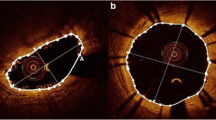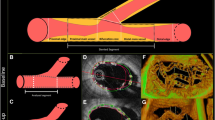Abstract
Heterogeneity of neointimal thickness is observed after drug-eluting stents implantation in bifurcation lesions (BL). We evaluated the vascular response of everolimus-eluting bioresorbable scaffold (BRS) struts deployed at BL using optical coherence tomography (OCT). 50 patients (64 scaffolds) underwent follow-up OCT after BRS implantation. Cross-sectional areas of each BL with a side branch more than 1.5 mm were analyzed using OCT every 200 µm. All images were divided into three regions according to shear stress: the 1/2 circumference of the vessel opposite to the ostium (OO), the vessel wall adjacent to the ostium (AO) and the side-branch ostium (SO). The %uncovered strut and the averaged neointimal thickness (NIT) were calculated. Overall, there were significant differences in both NIT and %uncovered strut among the three regions (OO, 119.2 ± 68.5 μm vs. AO, 94.2 ± 35.7 μm vs. SO, 80.5 ± 41.4 μm, p = 0.03; OO, 0.4 %vs. AO, 1.4 %vs. SO, 4.8 %, p = 0.02). Scaffolds were divided into two groups: a large-ratio side-branch group (LRSB; n = 32) and a small-ratio side-branch group (SRSB; n = 32), based on the median value of the ratio of the diameter of side branch ostium (Ds) to that of the main branch (Dm). In the LRSB alone, there were significant differences in both NIT and %uncovered strut among the three regions (OO, 128.0 ± 61.1 μm vs. AO, 97.3 ± 34.3 μm vs. SO, 75.9 ± 39.4 μm, p < 0.01; OO, 0.3 % vs. AO, 2.3 % vs. SO, 8.7 %, p < 0.01). After BRS implantation in BL, neointimal response was pronounced at the vessel wall opposite to the side branch ostium, especially in those with large side branches.


Similar content being viewed by others
References
Farb A, Heller PF, Shroff S, Cheng L, Kolodgie FD, Carter AJ et al (2001) Pathological analysis of local delivery of paclitaxel via a polymer-coated stent. Circulation 104:473–479
Farb AM, Burke APM, Kolodgie FDP, Virmani RM (2003) Pathological mechanisms of fatal late coronary stent thrombosis in humans. Circulation 108:1701–1706
Virmani R, Guagliumi G, Farb A, Musumeci G, Grieco N, Motta T et al (2004) Localized hypersensitivity and late coronary thrombosis secondary to a sirolimus-eluting stent: should we be cautious? Circulation 109:701–705
Joner M, Finn AV, Farb A, Mont EK, Kolodgie FD, Ladich E et al (2006) Pathology of drug-eluting stents in humans: delayed healing and late thrombotic risk. J Am Coll Cardiol 48:193–202
Finn AV, Joner M, Nakazawa G, Kolodgie F, Newell J, John MC et al (2007) Pathological correlates of late drug-eluting stent thrombosis thrombosis: strut coverage as a marker of endothelialization. Circulation 115:2435–2441
Iakovou I, Schmidt T, Bonizzoni E, Ge L, Sangiorgi GM, Stankovic G et al (2005) Incidence, predictors, and outcome of thrombosis after successful implantation of drug-eluting stents. JAMA 293:2126–2130
Nakazawa G, Yazdani SK, Finn AV, Vorpahl M, Kolodgie FD, Virmani R (2010) Pathological findings at bifurcation lesions: the impact of flow distribution on atherosclerosis and arterial healin after stent implantation. J Am Coll Cardiol 55:1679–1687
Malek AM, Alper SL, Izumo S (1999) Hemodynamic shear stress and its role in atherosclerosis. JAMA 282:2035–2042
Asakura T, Karino T (1990) Flow patterns and spatial distribution of atherosclerotic lesions in human coronary arteries. Circ Res 66:1045–1066
Onuma Y, Serruys PW, Perkins LE, Okamura T, Gonzalo N, García-García HM et al (2010) Intracoronary optical coherence tomography and histology at 1 month and 2, 3, and 4 years after implantation of everolimus-eluting bioresorbable vascular scaffolds in a porcine coronary artery model: an attempt to decipher the human optical coherence tomography images in the ABSORB trial. Circulation 122:2288–2300
Bourantas CV, Papafaklis MI, Kotsia A, Farooq V, Muramatsu T, Gomez-Lara J et al (2014) Effect of the endothelial shear stress patterns on neointimal proliferation following drug-eluting bioresorbable vascular scaffold implantation: an optical coherence tomography study. JACC Cardiovasc Interv 7:315–324
Yoshimura T, Tanaka A, Mori N, Nakamura D, Taniike M, Makino N et al (2014) Difference of neointimal growth patterns in bifurcation lesions among four kinds of drug-eluting stents: an optical coherence tomographic study. Catheter Cardiovasc Interv 84:742–749
Kyono H, Guagliumi G, Sirbu V, Rosenthal N, Tahara S, Musumeci G et al (2010) Optical coherence tomography (OCT) strut-level analysis of drug-eluting stents (DES) in human coronary bifurcations. EuroIntervention 6:69–77
Gutiérrez-Chico JL, Gijsen F, Regar E, Wentzel J, de Bruyne B, Thuesen L et al (2012) Differences in neointimal thickness between the adluminal and the abluminal sides of malapposed and side-branch struts in a polylactide bioresorbable scaffold: evidence in vivo about the abluminal healing process. JACC Cardiovasc Interv 5:428–435
Farooq V, Serruys PW, Heo JH, Gogas BD, Onuma Y, Perkins LE et al (2013) Intracoronary optical coherence tomography and histology of overlapping everolimus-eluting bioresorbable vascular scaffolds in a porcine coronary artery model: the potential implications for clinical practice. JACC Cardiovasc Interv 6:523–532
Nakatani S, Sotomi Y, Ishibashi Y, Grundeken MJ, Tateishi H, Tenekecioglu E et al (2015) Comparative analysis method of permanent metallic stents (XIENCE) and bioresorbable poly-l-lactic (PLLA) scaffolds (Absorb) on optical coherence tomography at baseline and follow-up. EuroIntervention 11. doi:10.4244/EIJY15M10_03
Liu Y, Imanishi T, Kubo T, Tanaka A, Kitabata H, Tanimoto T et al (2011) Assessment by optical coherence tomography of stent struts across side branch. -Comparison of bare-metal stents and drug-elution stents. Circ J 75:106–112
Papafaklis MI, Bourantas CV, Theodorakis PE, Katsouras CS, Naka KK, Fotiadis DI et al (2010) The effect of shear stress on neointimal response following sirolimus- and paclitaxel-eluting stent implantation compared with baremetal stents in humans. JACC Cardiovasc Interv 3:1181–1189
McDaniel MC, Samady H (2011) The sheer stress of straightening the curves: biomechanics of bioabsorbable stents. JACC Cardiovasc Interv 4:800–802
Gomez-Lara J, Brugaletta S, Farooq V, van Geuns RJ, De Bruyne B, Windecker S et al (2011) Angiographic geometric changes of the lumen arterial wall after bioresorbable vascular scaffolds and metallic platform stents at 1-year follow-up. JACC Cardiovasc Interv 4:789–799
Kalsho G, Kassab GS (2004) Bifurcation asymmetry of the porcine coronary vasculature and its implications on coronary flow heterogeneity. Am J Physiol Heart Circ Physiol 287:2493–2500
Kim JS, Jang IK, Kim TH, Takano M, Kume T, Hur NW et al (2009) Optical coherence tomography evaluation of zotarolimus-eluting stents at 9-month follow-up: comparison with sirolimus-eluting stents. Heart 95:1907–1912
Inoue T, Shite J, Yoon J, Shinke T, Otake H, Sawada T et al (2011) Optical coherence evaluation of everolimuseluting stents 8 months after implantation. Heart 97:1379–1384
Her AY, Lee BK, Shim JM, Kim JS, Kim BK, Ko YG et al (2010) Neointimal coverage on drug-eluting stent struts crossing side-branch vessels using optical coherence tomography. Am J Cardiol 105:1565–1569
Sato K, Panoulas VF, Kawamoto H, Naganuma T, Miyazaki T, Latib A et al (2015) Side branch occlusion after bioresorbable vascular scaffold implantation: lessons from optimal coherence tomography. JACC Cardiovasc Interv 8:116–118
Tamburino C, Latib A, van Geuns RJ, Sabate M, Mehilli J, Gori T et al (2015) Contemporary practice and technical aspects in coronary intervention with bioresorbable scaffolds: a European perspective. EuroIntervention 11:45–52
Costopoulos C, Latib A, Naganuma T, Miyazaki T, Sato K, Figini F et al. Comparison of early clinical outcomes between ABSORB bioresorbable vascular scaffold and everolimus-eluting stent implantation in a real-world population. Catheter Cardiovasc Interv 2015; 85: doi:10.1002/ccd.25569
Author information
Authors and Affiliations
Corresponding author
Ethics declarations
Conflict of interest
The authors declare that there was no funding nor any other conflicts of interest related to this work.
Rights and permissions
About this article
Cite this article
Sato, T., Jose, J., El-Mawardy, M. et al. Neointimal response to everolimus-eluting bioresorbable scaffolds implanted at bifurcating coronary segments: insights from optical coherence tomography. Int J Cardiovasc Imaging 33, 169–175 (2017). https://doi.org/10.1007/s10554-016-0993-y
Received:
Accepted:
Published:
Issue Date:
DOI: https://doi.org/10.1007/s10554-016-0993-y




